Simulation and Optimization of the Throttle Releaser in Aerated Irrigation Systems
Abstract
:1. Introduction
2. Materials and Methods
3. Simulation Analysis
3.1. Analysis of Pressure Field Variations
3.2. Analysis of Velocity Variations
3.3. Analysis of Turbulent Kinetic Energy Variation
3.4. Analysis of Air-Phase Distribution
4. Simulation and Optimization of the Multi-Throat W-Chamber Type Releaser
4.1. Simulation and Interactive Experiment of Multi-Throat W-Chamber Type Releaser
4.2. Analysis of Air-Phase Distribution Cloud Chart Inside the Releaser
4.3. Analysis of Pressure Variation Cloud Maps within the Releaser
4.4. Analysis of Velocity and Turbulent Kinetic Energy Distribution within the Releaser
5. Performance Test of the Multi-Throat W-Chamber Type Releaser
6. Conclusions
Author Contributions
Funding
Institutional Review Board Statement
Data Availability Statement
Conflicts of Interest
References
- Xiao, Y.; Sun, C.; Wang, D.; Li, H.; Guo, W. Analysis of Hotspots in Subsurface Drip Irrigation Research Using CiteSpace. Agriculture 2023, 13, 1463. [Google Scholar] [CrossRef]
- Du, Y.-D.; Niu, W.-Q.; Gu, X.-B.; Zhang, Q.; Cui, B.-J.; Zhao, Y. Crop yield and water use efficiency under aerated irrigation: A meta-analysis. Agric. Water Manag. 2018, 210, 158–164. [Google Scholar] [CrossRef]
- Wang, J.W.; Cui, Y.Q.; Wu, K.L.; Wu, S.Y.; Wu, K.J.; Li, Y.; Wenquan, N. Micro/nanobubble-aerated drip irrigation affects saline soil microenvironments and tomato growth by altering bacterial communities. Soil Tillage Res. 2024, 239, 106034. [Google Scholar] [CrossRef]
- Jin, C.C.; Lei, H.J.; Chen, J.; Xiao, Z.Y.; Leghari, S.J.; Yuan, T.Y.; Pan, H.W. Effect of Soil Aeration and Root Morphology on Yield under Aerated Irrigation. Agronomy 2023, 13, 369. [Google Scholar] [CrossRef]
- Baram, S.; Weinstein, M.; Evans, J.F.; Berezkin, A.; Sade, Y.; Ben-Hur, M.; Bernstein, N.; Mamane, H. Drip irrigation with nanobubble oxygenated treated wastewater improves soil aeration. Sci. Hortic. 2022, 291, 110550. [Google Scholar] [CrossRef]
- Bhattarai, S.P.; Su, N.H.; Midmore, D.J.; Sparks, D.L. Oxygation Unlocks Yield Potentials of Crops in Oxygen-Limited Soil Environments. Adv. Agron. 2005, 88, 313. [Google Scholar] [CrossRef]
- Cui, J.P.; Tan, F. PLSR-Based Assessment of Soil Respiration Rate Changes under Aerated Irrigation in Relation to Soil Environmental Factors. Agriculture 2023, 13, 68. [Google Scholar] [CrossRef]
- Li, Y.; Zhang, Z.X.; Wang, J.W.; Zhang, M.Z. Soil Aeration and Plastic Film Mulching Increase the Yield Potential and Quality of Tomato (Solanum lycopersicum). Agriculture 2022, 12, 269. [Google Scholar] [CrossRef]
- Xiao, Z.Y.; Lei, H.J.; Jin, C.C.; Pan, H.W.; Lian, Y.J. Relationship between the Dynamic Characteristics of Tomato Plant Height and Leaf Area Index with Yield, under Aerated Drip Irrigation and Nitrogen Application in Greenhouses. Agronomy 2023, 13, 116. [Google Scholar] [CrossRef]
- Sariyev, A.; Barutcular, C.; Acar, M.; Hossain, A.; El Sabagh, A. Sub-Surface Drip Irrigation in Associated with H2O2 Improved the Productivity of Maize under Clay-Rich Soil of Adana, Turkey. Phyton-Int. J. Exp. Bot. 2020, 89, 519–528. [Google Scholar] [CrossRef]
- Zhao, H.; Li, L.; Fan, G.H.; Xie, S.Z.; Li, F.H. Effects of aerated brackish water irrigation on growth of Lycium barbarum seedlings. Sci. Hortic. 2023, 310, 111721. [Google Scholar] [CrossRef]
- Seifi, A.; Mirlatifi, S.M. Irrigation Water Use Efficiency and Yield of Pistachio under Aerated Subsurface Drip Irrigation System. J. Agric. Sci. Technol. 2020, 22, 1655–1671. [Google Scholar]
- Andinet, T.; Kim, I.; Lee, J.Y. Effect of microbubble generator operating parameters on oxygen transfer efficiency in water. Desalination Water Treat. 2016, 57, 26327–26335. [Google Scholar] [CrossRef]
- Parmar, R.; Majumder, S.K. Terminal rise velocity, size distribution and stability of microbubble suspension. Asia-Pacific J. Chem. Eng. 2015, 10, 450–465. [Google Scholar] [CrossRef]
- Li, J.; Fan, Y.; Han, J.; Liu, Z. Experimental Study on Generation of Micro-bubble Based on Dissolution of Gas Through Pressurizing. J. Xi’an Shiyou Univ. (Nat. Sci. Ed.) 2018, 33, 122–126. [Google Scholar] [CrossRef]
- Yamashita, H.; Aoyagi, H.; Minagawa, H. Enhancement of microbubble generation in a pressurized dissolution process by packing the nozzle with porous ceramics. Water Sci. Technol. 2012, 65, 69–75. [Google Scholar] [CrossRef]
- Sun, H. Research progress of microbubble generator. Energy Chem. Ind. 2022, 43, 39–44. [Google Scholar]
- Lee, C.H.; Choi, H.; Jerng, D.W.; Kim, D.E.; Wongwises, S.; Ahn, H.S. Experimental investigation of microbubble generation in the venturi nozzle. Int. J. Heat Mass Transf. 2019, 136, 1127–1138. [Google Scholar] [CrossRef]
- Wu, M.; Song, H.; Liang, X.; Huang, N.; Li, X. Generation of micro-nano bubbles by self-developed swirl-type micro-nano bubble generator. Chem. Eng. Process.-Process Intensif. 2022, 181, 109136. [Google Scholar] [CrossRef]
- Deng, C.; Yang, L.; Chen, H.J.; Yang, M.C.; Zhu, Y.Z. Progresses in Research and Application of Micro-Nano Bubble Generating Device. Petrochem. Technol. 2014, 43, 61–63. [Google Scholar]
- Satpathy, K.; Rehman, U.; Cools, B.; Verdickt, L.; Peleman, G.; Nopens, I. CFD-Based process optimization of a dissolved air flotation system for drinking water production. Water Sci. Technol. 2020, 81, 1668–1681. [Google Scholar] [CrossRef]
- Schofield, T. Dissolved air flotation in drinking water production. Water Sci. Technol. 2001, 43, 9–18. [Google Scholar] [CrossRef]
- Zhang, X.H.; Zhang, X.W.; Liu, Y.P.; Zhang, Q.; Yang, S.P.; He, X.W. Removal of viscous and clogging suspended solids in the wastewater from acrylonitrile-butadiene-styrene resin production by a new dissolved air release device. Process Saf. Environ. Prot. 2021, 148, 524–535. [Google Scholar] [CrossRef]
- Liu, Y.; Jiang, C.; Gong, L.; Xie, H.; Gao, J. Discussion on Research Progress of Aerobic Irrigation. J. Agric. Disaster Res. 2023, 13, 61–63. [Google Scholar]
- Zabel, T. The advantages of dissolved-air flotation for water treatment. J. Am. Water Work. Assoc. 1985, 77, 42–46. [Google Scholar] [CrossRef]
- Yue, P.; Liu, Z. Numerical Simulation of the Inlet Pressure TS Type Affect Release of Dissolved Gas Performance. Guangdong Chem. Ind. 2016, 43, 9–10+3. [Google Scholar]
- Fletcher, D.F.; McClure, D.D.; Kavanagh, J.M.; Barton, G.W. CFD simulation of industrial bubble columns: Numerical challenges and model validation successes. Appl. Math. Model. 2017, 44, 25–42. [Google Scholar] [CrossRef]
- Alam, H.S.; Sutikno, P.; Soelaiman, T.A.F.; Sugiarto, A.T. CFD-PBM Coupled modeling of bubble size distribution in a swirling-flow nanobubble generator. Eng. Appl. Comput. Fluid Mech. 2022, 16, 677–693. [Google Scholar] [CrossRef]
- Arias, S.; Montlaur, A. Influence of contact angle boundary condition on CFD simulation of T-junction. Microgravity Sci. Technol. 2018, 30, 435–443. [Google Scholar] [CrossRef]
- Yang, H.; Kong, L.; Chen, J.; Sun, H.; Song, J.; Kong, B.; Ding, G. Gas-Liquid Two-Phase Flow Characteristic Research on Micro Bubble Tubular Gas-Liquid Contactor. J. Petrochem. Univ. 2024, 37, 25–33. [Google Scholar] [CrossRef]
- Liew, K.C.S.; Rasdi, A.; Budhijanto, W.; Yusoff, M.H.M.; Bilad, M.R.; Shamsuddin, N.; Nordin, N.A.H.M.; Putra, Z.A. Porous Venturi-Orifice Microbubble Generator for Oxygen Dissolution in Water. Processes 2020, 8, 10. [Google Scholar] [CrossRef]
- Nouri, N.M.; Sarreshtehdari, A.; Maghsoudi, E. Improvement of A Microbubble Generator’s Performance via Reliance on Fluid Dynamics Characteristics. J. Mech. 2009, 25, 189–194. [Google Scholar] [CrossRef]
- Yun, J.-E. CFD Analysis for the Design of a Venturi Tube-type Air Bubble Generator with Porous Material Throat. Trans. KSME B 2016, 40, 667–672. [Google Scholar] [CrossRef]
- Li, X.H.; Su, W.B.; Liu, Y.; Yan, X.K.; Wang, L.J.; Zhang, H.J. Comparison of bubble velocity, size, and holdup distribution between single- and double-air inlet in jet microbubble generator. Asia-Pac. J. Chem. Eng. 2021, 16, e2611. [Google Scholar] [CrossRef]
- Pang, M.J.; Wei, J.J.; Yu, B. Study on Liquid Turbulence Modulation by Microbubbles in Different Turbulence Layers. Adv. Mech. Eng. 2014, 6, 647467. [Google Scholar] [CrossRef]
- Kitagawa, A.; Hishida, K.; Kodama, Y. Flow structure of microbubble-laden turbulent channel flow measured by PIV combined with the shadow image technique. Exp. Fluids 2005, 38, 466–475. [Google Scholar] [CrossRef]
- Guo, X.; Li, Q.; Zhang, J.; Lei, M.; Liu, J.; Zhu, H. Structural Optimization Study of Microbubble Generator. J. Eng. Thermophys. 2023, 44, 1815–1822. [Google Scholar]
- Liu, S.; Niu, H.; Yue, P. Effect of Outlet Diameter on Microbubbles Formation in Dissolved Air Releaser. Technol. Dev. Chem. Ind. 2021, 50, 62–65. [Google Scholar]
- Wu, Y.X.; Chen, H.; Song, X.F. An investigation on the effect of open hole number and scheme on single-phase flow of a swirl flow bubble generator. Korean J. Chem. Eng. 2023, 40, 754–769. [Google Scholar] [CrossRef]
- Zhang, X.; Liu, F.; Wang, W. Mechanism research of bubble fragmentation of Venturi bubble generator. Pet. Refin. Eng. 2023, 53, 9–11+34. [Google Scholar]
- Gao, H.; Wei, Z.; Shi, Y.; Xu, H.; Wang, H. Design of the CFD numerical simulation-based bubble generator of jet microbubble flotation cell. Coal Prep. Technol. 2023, 51, 30–37. [Google Scholar] [CrossRef]
- Wang, X.Y.; Shuai, Y.; Zhang, H.M.; Sun, J.Y.; Yang, Y.; Huang, Z.L.; Jiang, B.B.; Liao, Z.W.; Wang, J.D.; Yang, Y.R. Bubble breakup in a swirl-venturi microbubble generator. Chem. Eng. J. 2021, 403, 126397. [Google Scholar] [CrossRef]
- Li, Q.; Guo, X.; Zhang, J.; Lei, M.; Liu, J.L.; Ming, D.Z.; Fang, L. Mechanism of Microbubbles and Cavitation Effect on Bubble Breakage in a Venturi Bubble Generator. J. Appl. Fluid Mech. 2023, 16, 778–793. [Google Scholar] [CrossRef]
- Park, J.S.; Kurata, K. Application of Microbubbles to Hydroponics Solution Promotes Lettuce Growth. Horttechnology 2009, 19, 212–215. [Google Scholar] [CrossRef]
- Chen, E.; Zhang, Y.; Lu, S.; Duan, H.; Jin, W. Stability and physicochemical properties of air nanobubbles. Chem. Ind. Eng. Prog. 2022, 41, 4673–4681. [Google Scholar] [CrossRef]
- Liu, Y.F.; Wang, G.C.; Zhang, X.N.; Li, H.C.; Si, B.C.; Liu, W.Q.; Zhang, Z.H. Motion Characteristics of Gas–Liquid Two-Phase Flow of Microbubbles in a Labyrinth Channel Used for Aerated Drip Irrigation. Water 2023, 15, 1432. [Google Scholar] [CrossRef]
- Roohi, R.; Abedi, E.; Hashemi, S.M.B.; Marszalek, K.; Lorenzo, J.M.; Barba, F.J. Ultrasound-assisted bleaching: Mathematical and 3D computational fluid dynamics simulation of ultrasound parameters on microbubble formation and cavitation structures. Innov. Food Sci. Emerg. Technol. 2019, 55, 66–79. [Google Scholar] [CrossRef]
- Lei, H.J.; Liu, H.; Balsys, R.; Midmore, D.J.; Zang, M.; Bhattarai, S. Factors of relevance for improving the uniformity of oxygen distribution in drip irrigation water. Irrig. Drain. 2020, 69, 1133–1145. [Google Scholar] [CrossRef]
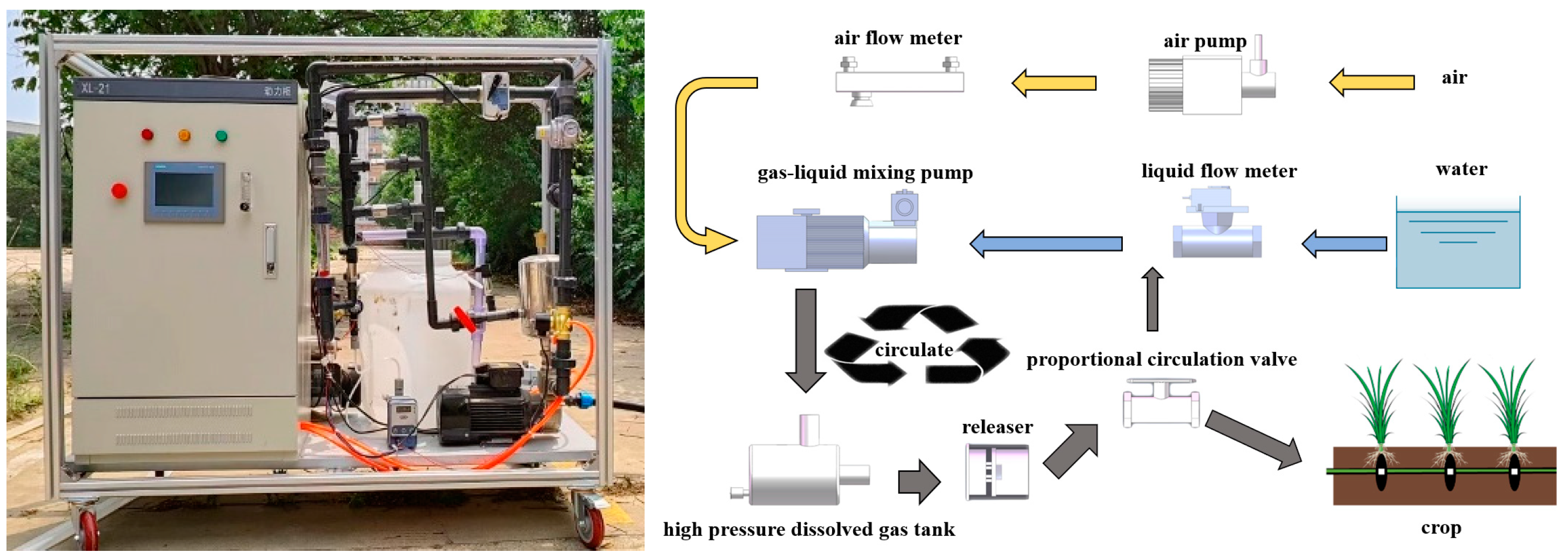
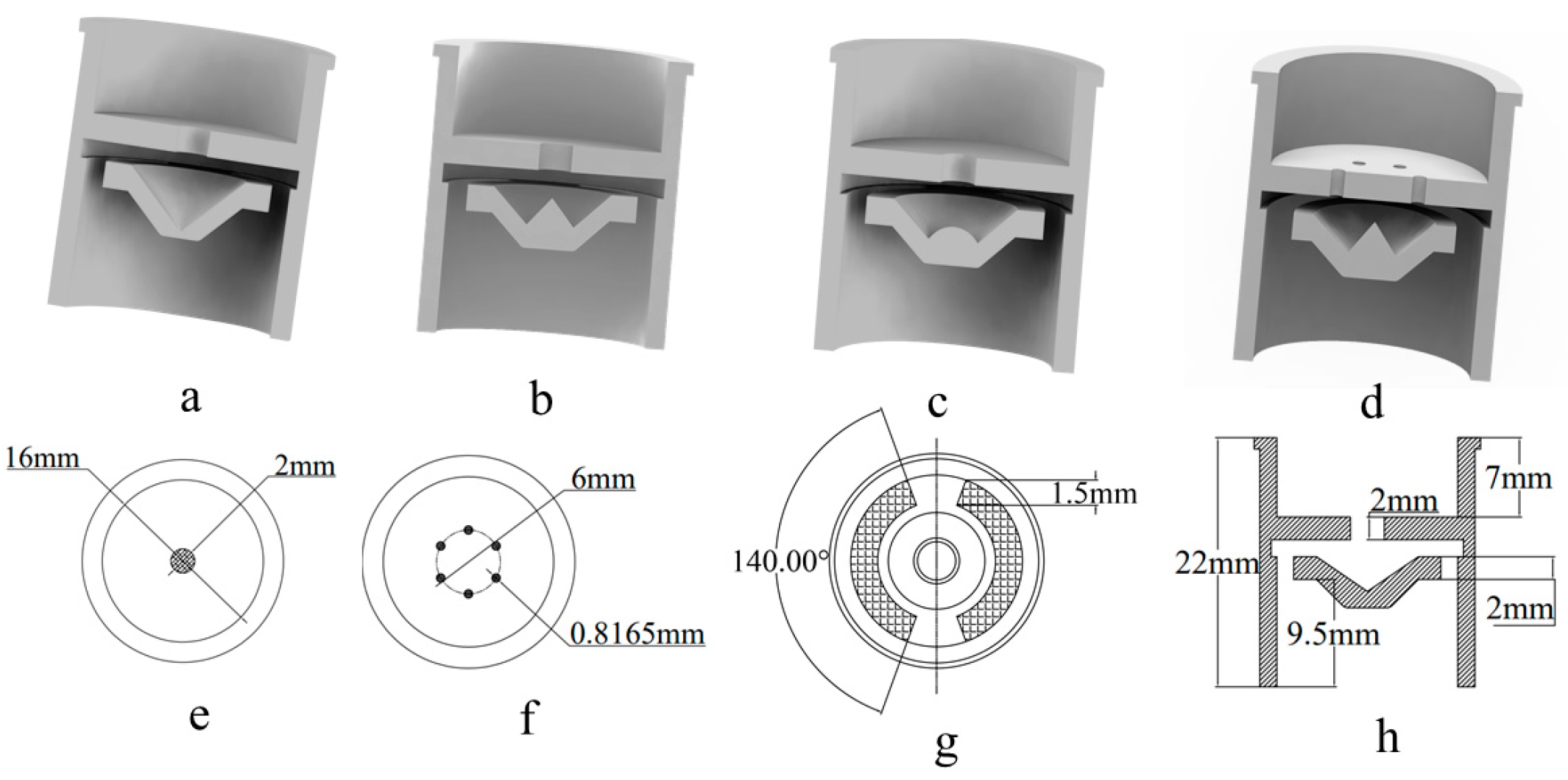



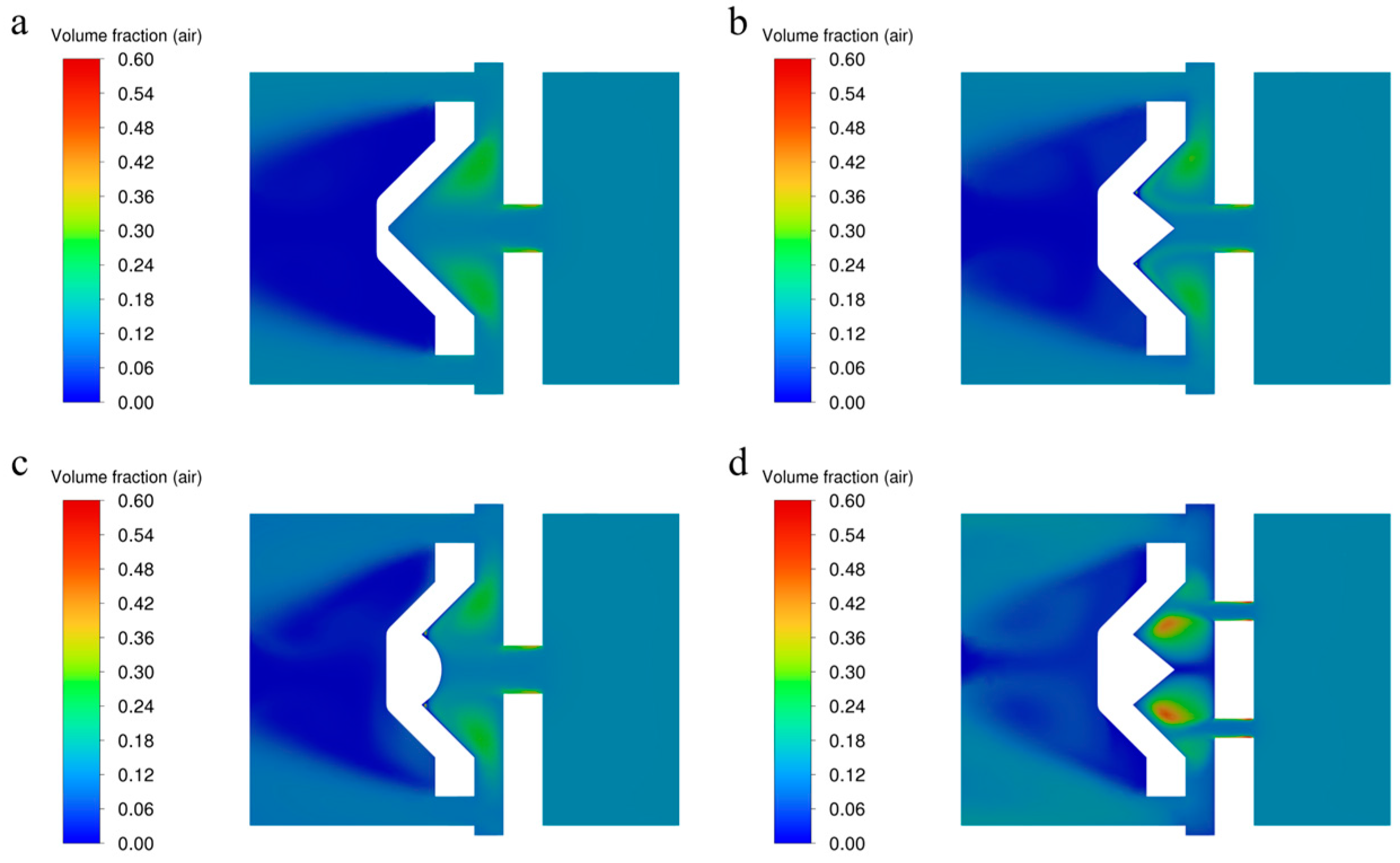
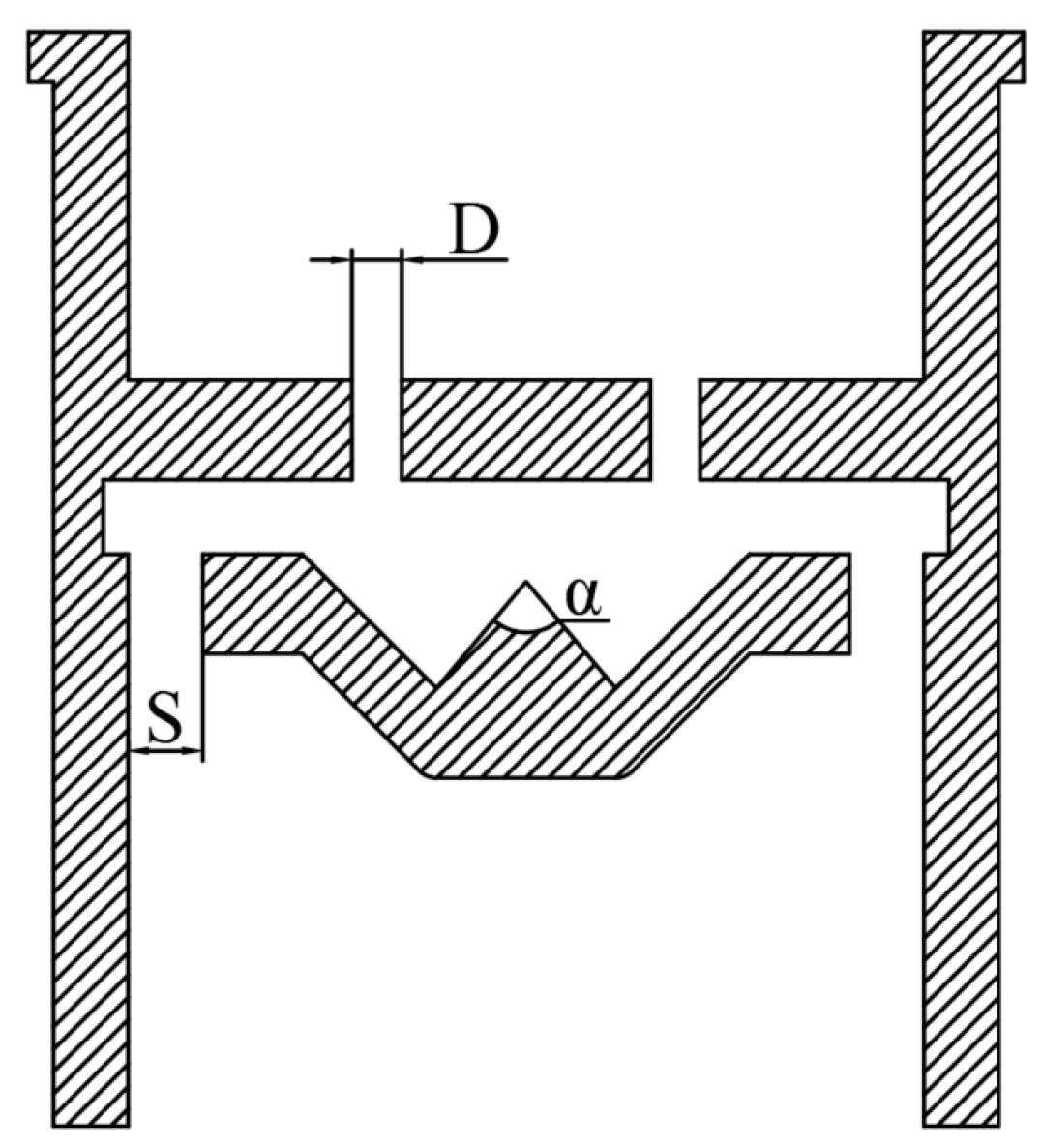



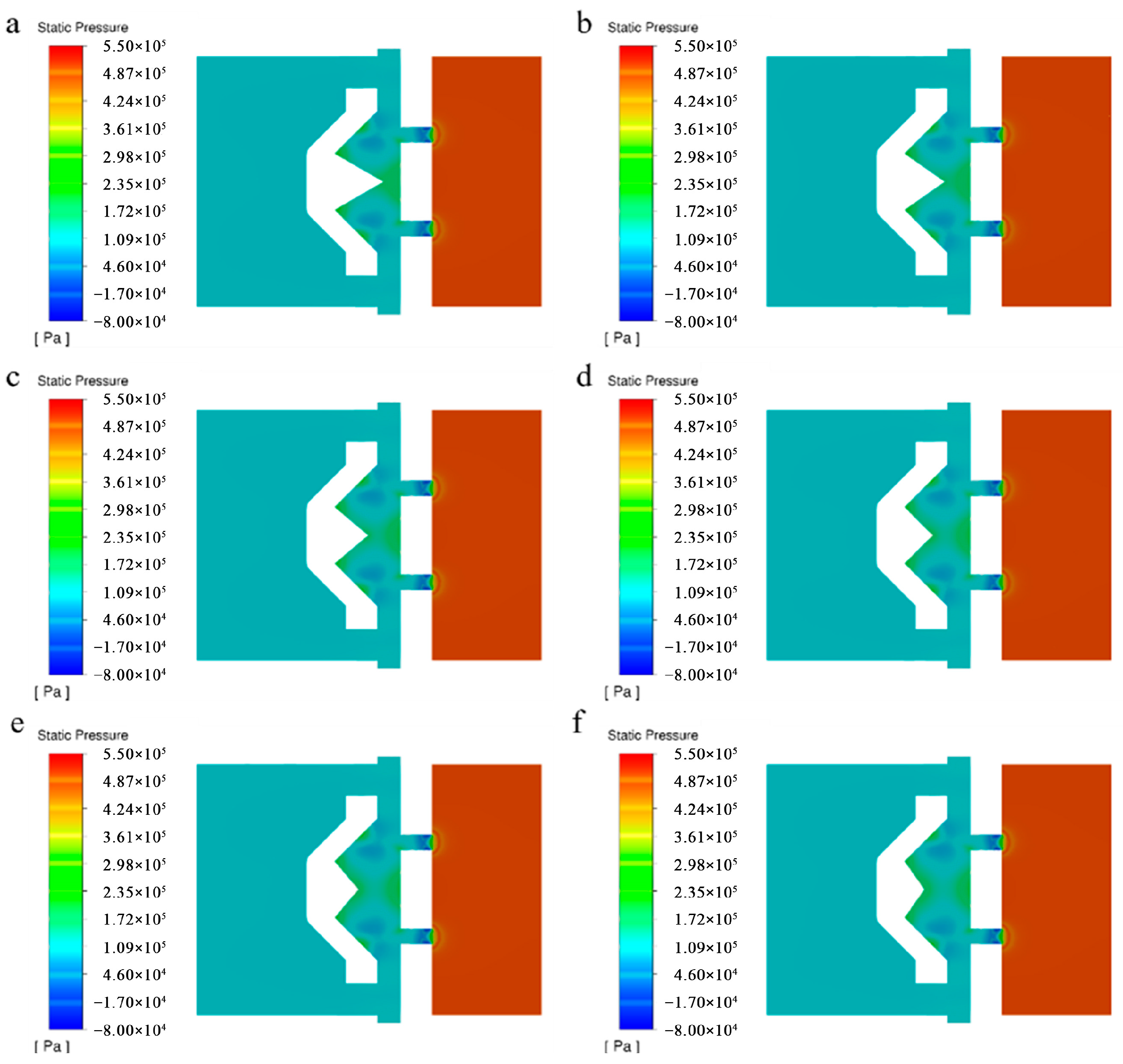




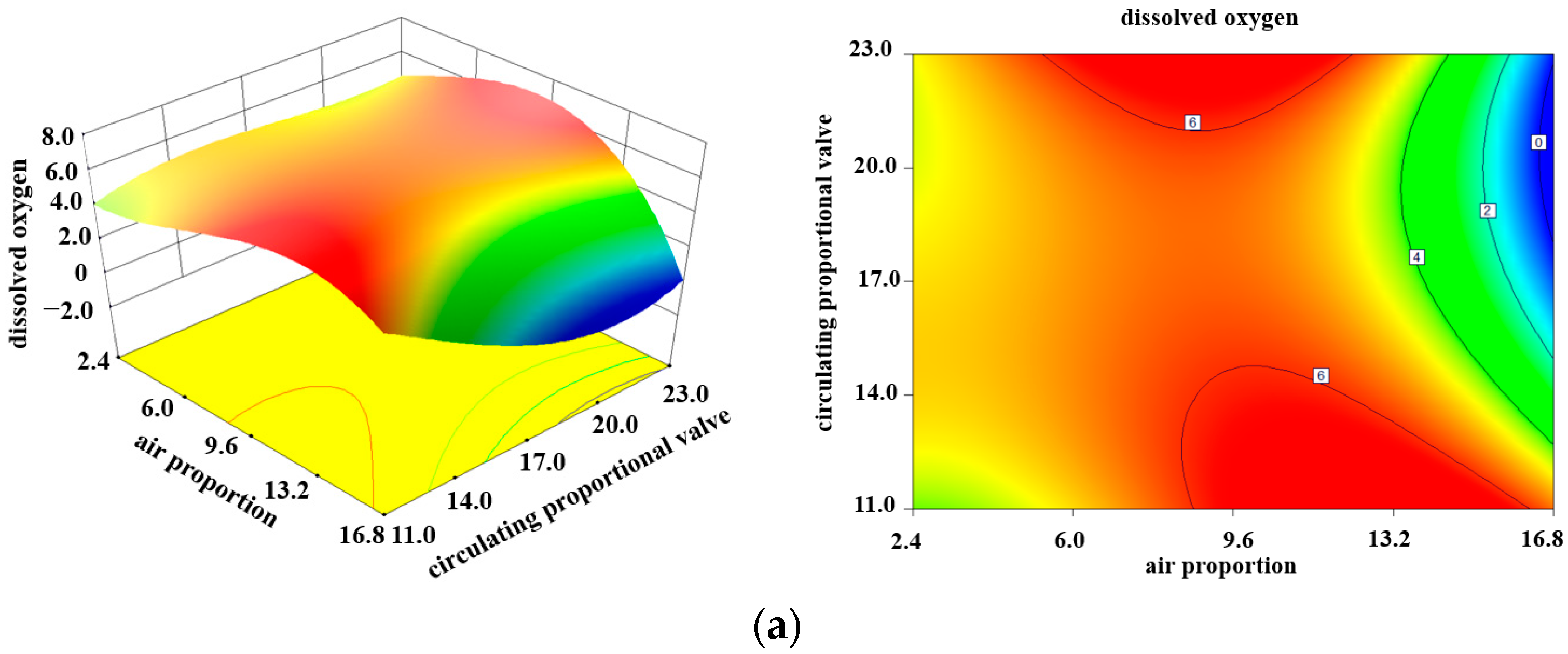

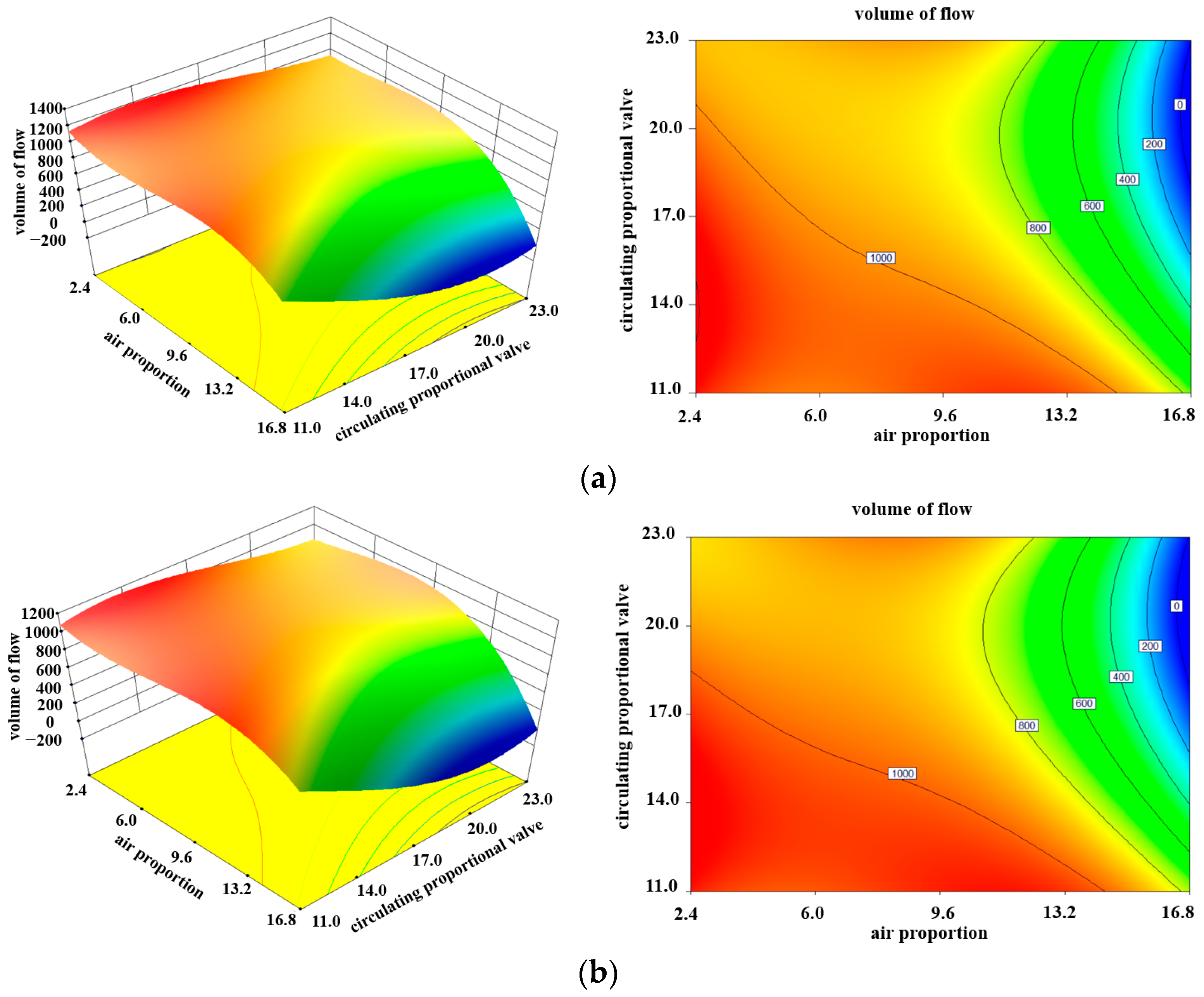
| Type | Parameter | Traditional Releaser | W-Type Releaser | Arc-Shaped Releaser | Multi-Throat W-Type Releaser |
|---|---|---|---|---|---|
| Surface mesh | Minimum size (mm) | 0.005 | 0.005 | 0.005 | 0.005 |
| Maximum size (mm) | 0.625 | 0.625 | 0.625 | 0.625 | |
| Growth rate | 1.1 | 1.1 | 1.1 | 1.1 | |
| Boundary layers | 3 | 3 | 3 | 3 | |
| Transition ratio | 0.272 | 0.272 | 0.272 | 0.272 | |
| Growth rate (layers) | 1.2 | 1.2 | 1.2 | 1.2 | |
| Volumetric mesh | Maximum size (mm) | 0.6 | 0.6 | 0.6 | 0.6 |
| Growth rate | 1.1 | 1.1 | 1.1 | 1.1 |
| Ref | α (°) | D (mm) | S (mm) | Air Proportion (%) | Outlet Turbulence (m2/s2) | All Turbulence (m2/s2) |
|---|---|---|---|---|---|---|
| 1 | 85 | 1 | 0.8 | 0.06740487 | 0.07257083 | 1,697,998 |
| 2 | 60 | 2.5 | 1.2 | 0.09596661 | 0.1689876 | 2,063,751 |
| 3 | 85 | 1.5 | 1.2 | 0.0729967 | 0.2762425 | 2,291,974 |
| 4 | 70 | 1.75 | 1 | 0.1016652 | 0.1453521 | 1,961,270 |
| 5 | 85 | 1.75 | 1.2 | 0.08246482 | 0.2694711 | 2,316,067 |
| 6 | 110 | 1 | 1.2 | 0.06084122 | 0.3131938 | 2,496,721 |
| 7 | 90 | 2 | 1.2 | 0.09529056 | 0.2722709 | 2,389,501 |
| 8 | 85 | 1 | 1.6 | 0.06238334 | 0.8657846 | 2,491,963 |
| 9 | 60 | 1.75 | 1.6 | 0.07308838 | 0.7617085 | 2,231,241 |
| 10 | 60 | 1.75 | 0.8 | 0.08249355 | 0.04903713 | 997,251.1 |
| 11 | 85 | 2.5 | 1.6 | 0.1138487 | 0.6491916 | 1,086,193 |
| 12 | 110 | 1.75 | 0.8 | 0.07741882 | 0.05104568 | 1,817,445 |
| 13 | 110 | 1.75 | 1.6 | 0.07476543 | 0.7596618 | 2,920,059 |
| 14 | 60 | 1 | 1.2 | 0.06148825 | 0.3116685 | 1,983,523 |
| 15 | 110 | 2.5 | 1.2 | 0.1083448 | 0.2679218 | 2,604,006 |
| 16 | 85 | 2.5 | 0.8 | 0.09886769 | 0.04746273 | 1,650,695 |
| 17 | 90 | 1.75 | 1.2 | 0.08737685 | 0.2779525 | 2,377,095 |
| Item | Type | Mean Square | F Value | p Value |
|---|---|---|---|---|
| Outlet air proportion | A | 1.999 × 10−3 | 23.34 | 0.0013 |
| B | 1.002 × 10−5 | 0.12 | 0.7411 | |
| C | 1.634 × 10−6 | 0.019 | 0.8936 | |
| Outlet turbulent | A | 0.041 | 6.22 | 0.0373 |
| B | 0.8 | 120.14 | <0.0001 | |
| C | 2.283 × 10−3 | 0.34 | 0.5743 | |
| All turbulence | A | 3.628 × 1011 | 1.53 | 0.2514 |
| B | 4.441 × 1011 | 1.87 | 0.2085 | |
| C | 8.141 × 1010 | 0.34 | 0.5743 |
| Item | Mean Square | F Value | p Value |
|---|---|---|---|
| A | 0.023 | 18.13 | 0.0013 |
| B | 1.17 | 919.68 | <0.0001 |
| AB | 0.012 | 9.47 | 0.0105 |
| A² | 2.618 × 10−3 | 2.05 | 0.18 |
| B² | 0.088 | 69.06 | <0.0001 |
| Air–liquid Volume Ratios | Circulating Proportional Valve | Multi-Throat W-Chamber Type Releaser | Traditional TS Releaser | ||
|---|---|---|---|---|---|
| Flow Rate | Dissolved Oxygen | Flow Rate | Dissolved Oxygen | ||
| 2.4% | 11° | 1164 | 4.25 | 1108 | 4.21 |
| 14° | 1145 | 4.52 | 1080 | 4.46 | |
| 17° | 1115 | 4.73 | 1032 | 4.76 | |
| 20° | 1088 | 4.95 | 984 | 4.91 | |
| 23° | 1002 | 5.08 | 912 | 4.79 | |
| 6% | 11° | 1080 | 5.56 | 1056 | 5.46 |
| 14° | 1056 | 5.69 | 1020 | 5.58 | |
| 17° | 1038 | 5.85 | 1008 | 5.65 | |
| 20° | 996 | 5.94 | 951 | 5.70 | |
| 23° | 912 | 6.02 | 891 | 5.73 | |
| 9.6% | 11° | 1042 | 5.9 | 1032 | 5.68 |
| 14° | 1008 | 5.95 | 1002 | 5.83 | |
| 17° | 981 | 5.95 | 976 | 5.93 | |
| 20° | 963 | 6.05 | 934 | 5.81 | |
| 23° | 876 | 5.97 | 888 | 5.75 | |
| 13.2% | 11° | 960 | 6.23 | 956 | 6.09 |
| 14° | 946 | 6.3 | 924 | 6.14 | |
| 17° | 924 | 6.36 | 876 | 5.98 | |
| 20° | 888 | 6.34 | 816 | 6.01 | |
| 23° | 828 | 6.29 | 764 | 5.95 | |
| 16.8% | 11° | 840 | 6.11 | 834 | 5.83 |
| 14° | 0 | 0 | 0 | 0 | |
| 17° | 0 | 0 | 0 | 0 | |
| 20° | 0 | 0 | 0 | 0 | |
| 23° | 0 | 0 | 0 | 0 | |
Disclaimer/Publisher’s Note: The statements, opinions and data contained in all publications are solely those of the individual author(s) and contributor(s) and not of MDPI and/or the editor(s). MDPI and/or the editor(s) disclaim responsibility for any injury to people or property resulting from any ideas, methods, instructions or products referred to in the content. |
© 2024 by the authors. Licensee MDPI, Basel, Switzerland. This article is an open access article distributed under the terms and conditions of the Creative Commons Attribution (CC BY) license (https://creativecommons.org/licenses/by/4.0/).
Share and Cite
Sun, C.; Wang, D.; Liu, H.; Xiao, Y.; Guo, W.; Liu, B. Simulation and Optimization of the Throttle Releaser in Aerated Irrigation Systems. Agriculture 2024, 14, 1248. https://doi.org/10.3390/agriculture14081248
Sun C, Wang D, Liu H, Xiao Y, Guo W, Liu B. Simulation and Optimization of the Throttle Releaser in Aerated Irrigation Systems. Agriculture. 2024; 14(8):1248. https://doi.org/10.3390/agriculture14081248
Chicago/Turabian StyleSun, Chaoxiang, Dezhe Wang, Hailin Liu, Yatao Xiao, Wei Guo, and Bing Liu. 2024. "Simulation and Optimization of the Throttle Releaser in Aerated Irrigation Systems" Agriculture 14, no. 8: 1248. https://doi.org/10.3390/agriculture14081248







